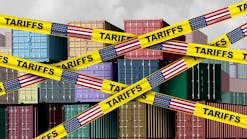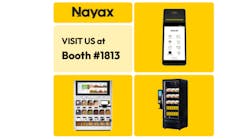For years the convenience services industry has been on the apex of a technological revolution. Early adopters saw the need to innovate and invest in technology. Now, there is a growing acknowledgement from operators at every level that they need to invest in order to stay competitive.
“My ‘What Must Be Done For 2019’ list includes upgrading remote monitoring devices from 3G to 4G,” said Sandy Thornton, co-owner and key accounts manager at VendEdge based in Roswell, GA. This is in addition to a 2019 wish list which includes adding an online ordering platform for office coffee service (OCS), utilizing artificial intelligence to drive up same location sales and getting handsfree glasses for route drivers. “This is after already conquering remote monitoring of vending, cashless for vending, dynamic scheduling for vending and markets, pre-kitting for vending and markets, and pick to light order fulfillment,” explained Thornton. She admits it can be overwhelming, but that it’s a necessary part of succeeding in today’s business environment.
The need for technology is part of the reason why 2018 had so much consolidation of operations, a trend that will not be stopping in 2019 either.
“I think we have been witnessing, over the past couple years and even as we look ahead in the coming years, a pivotal time for many vending operators,” said Elyssa Steiner, director of marketing for USA Technologies. “They are determining what to do with their business: 1) sell to another operator/company, OR, 2) invest in technology to grow their business, which sometimes also means growing their facilities and investing in new buildings, etc.”
Technology is being used to allow operators to do things better, faster and smarter, explains Steiner. “Look at the concept of Google glasses for example when it comes to picking. This was a way to create efficiencies for warehouse pickers, and then for drivers when stocking machines,” she said. Another concept she highlights is machine learning tools sometimes called artificial intelligence, which can help operators better maximize revenues, merchandise to consumer trends and ultimately sell more product.
It can be difficult and expensive, especially as technology continues to change, software and hardware needs to be updated and the continued support of connected technology drives up costs. There are a few main areas of focus, which include cashless, micro markets, prekitting and future innovations, in both payment acceptance and any technology that can produce better efficiency.
It can be difficult and expensive, especially as technology continues to change, software and hardware needs to be updated and the continued support of connected technology drives up costs. There are a few main areas of focus, which include cashless, micro markets, prekitting and future innovations, in both payment acceptance and any technology that can produce better efficiency.
Cashless acceptance
The percentage of vending machines in the industry that accept credit/debit cards or mobile payments is now well over 50 percent. Consumers are demanding it and many operators report a sales lift of both cash and credit once cashless payment is accepted. There are some challenges with cashless such as the elimination of the 2G, and some 3G networks, requiring updates to cashless devices that can not use 4G or LTE. Another is the cost of the device itself, keeping it connected via cellular signal and the fees from the processors when a consumer uses a card. It requires operators to somehow build those costs into the product prices and/or increase the number of items sold. With the Federal Reserve reporting that cashless payment use has been growing steadily since 2000, investing in cashless payment acceptance is a future-proof solution.
Micro markets grow
Micro markets not only allow the cashless acceptance operators currently struggle with adding to 100 percent of vending machines, but are a technology solution in themselves. It’s a solution that has plenty of interest from customers too. “We are finding new micro market business,” said Carl Moser, sales manager at Cardinal Canteen Food Service in Chesapeake, VA, “but we are also swapping over businesses to micro markets.” It’s been positive, with as much as 4 times the sales at a location that has been swapped over, Moser says. The future however is in going smaller. Moser sees many locations that have lower head counts, but who want micro markets. “It’s tougher to make the small micro market concept work,” said Moser.
Joe Hessling, CEO of 365 Retail Markets thinks Moser and the other operators experimenting with smaller markets will continue to do so in 2019. “We anticipate significant growth in smaller markets, 150 person and below,” he said. “Tablet and mobile should add at least 3,000 locations as opposed to 2018, where we think it was closer to 1,500 opened.”
These smaller micro market locations would be in addition to the 6,000 more traditional markets, with more than 150 employees, that Hessling guesses operators will open in 2019, a number he says is flat compared to 2018. These are not just estimates for 365 Retail Markets, but across the U.S. industry, according to Hessling. He also expects a lot of micro market growth outside the U.S.
Prekitting and using data
Technology on the inside of the operation is going to be big in 2019, in part because operators are looking at it to help with a tight labor market and increasing costs of goods.
“Labor costs are going up for us,” said Moser speaking about hiring employees. Josh Rosenberg, president and CEO of Accent Food Services in Pflugerville, TX, sees a similar trend. “The distribution industry is driving up the cost of labor for warehouse associates,” he said. Wages have been pushed up by 20 percent in some instances.
One helpful aspect of the tight labor market is that the businesses operators serve are struggling with the same issue, making convenience services more in demand. “On the positive side employers are leveraging our services as a must have to compete for top talent, sustain culture/high engagement and support workplace productivity,” added Rosenberg.
Inflation/cost of goods
The latest consumer price index reported a significant increase in gasoline prices ended October 2018, which drove up much of the “all items” index which increased 2.5 percent. There is worry we will see this type of cost increase in 2019, possibly even higher than a typical 2.5/3 percent increase that often comes with inflation. With tariffs on goods from China and instability in some of the largest oil producing countries looming, costs might rise closer to 5 percent or more, an increase that would be difficult for operators to pass on to end users.
Technology will be how many deal with these looming cost increases. Moser has a goal of really optimizing his business practices in the warehouse and during location service. “We put a lot of money into forecasting and prekitting, including someone internal we hired to look at the data and make suggestions,” he said, “because data doesn’t mean anything if you don’t go through it.”
Rosenberg also feels utilizing technology will be important. “For the industry to sustain our bottom lines, the cost of technology, cashless processing fees and operational efficiencies will be required to offset the [challenges],” said Rosenberg. “This will mean strong operators with operating discipline, leverage of technology and diverse channel participation will force additional operator consolidation and/or see an unbalanced growth within the operator community.”
Hessling sees a similar evolution. “The focus from the operators seems to be less on the revenue side,” said Hessling. “While they still demand revenue growth when investing in new technologies, they are now trying to keep up with the demands of having their entire business connected to a few technology providers and then spending their time on running their businesses as efficiently as possible with minimal downtime and hassle caused by their technology providers.”
Payment innovations
Investing in existing technologies that will benefit operators is important, but to stay strong, the industry will also have to look at what is coming.
“With the rate at which technology keeps moving, we as an entire industry are going to need to continuously look at innovating the services and goods we deliver to consumers,” Steiner said. “This industry is no longer about food and beverage. It is really about bringing convenience to consumers wherever they are.” She mentioned the distribution industry giant Amazon who is investing in thousands of AmazonGo stores. “...Competition is growing in unattended. We are not vending operators anymore, we are unattended retailers,” she said.
One evolution Steiner sees on the horizon is how payments are made and what types are accepted. For an example she goes back to Amazon and how consumers can use at-home devices such as Alexa to make orders and pay. Steiner wonders if operators can start doing new and innovative things with payments as well that will be meaningful to the consumer. “How do we as unattended retailers continue to evolve with the consumers demand for payment flexibility. Does that mean we start accepting new payments like Venmo at machines, Crypto-currencies, etc.? The ideas are endless, but if we stay open and curious about these trends we can ultimately get ahead of them and evolve with the consumer rather than be late to the party,” she said.
Hessling adds, “Technology will continue to push towards mobile and cashless with the focus on connecting all devices on a common platform in the workplace.” The future will be about payments and everything being connected seamlessly.
The right path
While 2019 will have challenges, it will also come with plenty of opportunities. “2019 has me as excited as ever for industry!” said Jeff Whitacre, president and CEO of USConnect. “The economy has heated up and for the first time in a decade same store account sales are rising as employers are adding employees and employees are spending more money. In addition to this, operators continue to transform their businesses by adding cashless acceptance to their vending machines and deploying micro markets where applicable. This combination has me expecting 2019 to be a record sales year for my operating company and all of the operating companies within USConnect.”
Technology Changes How Today’s Decision Makers Choose Convenience Services
Operators now have more to consider when they sell their services to a company. Decision makers have instant access to all service providers in their area thanks to search engines. They can read online reviews and compare services more easily. Carl Moser, sales manager at Cardinal Canteen Food Service points to the fact that selling a location used to be more about personal relationships. Today the young decision makers want numbers and digital communication.
“It takes education of the younger generation on the benefit of service while still adapting to how they want sales information,” said Moser. “Because without the service there is nothing that sets your operation apart. It’s different than it was 10 to 15 years ago.”

Emily Refermat
Emily began covering the vending industry in 2006 and became editor of Automatic Merchandiser in 2012. Usually, Emily tries the new salted snack in the vending machine, unless she’s on deadline — then it’s a Snickers.
Emily resigned from Automatic Merchandiser and VendingMarketWatch.com in 2019 to pursue other opportunities.







